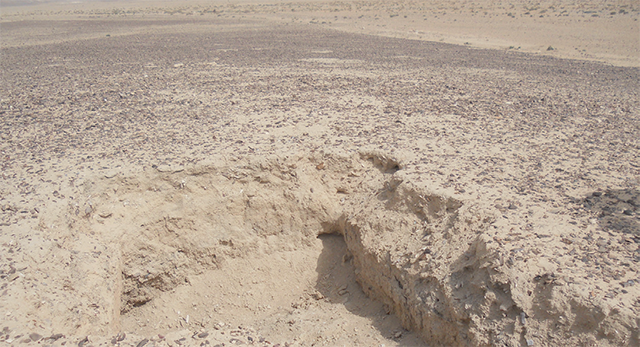You are here
Decoding secrets of ephemeral archaeological sites through creative analysis
By Saeb Rawashdeh - Dec 28,2023 - Last updated at Dec 28,2023

Excavating ephemeral site of Wadi Jilat (Photo courtesy of Daniella Vos)
AMMAN — Gathering information from ephemeral archaeological sites is more difficult than researching a regular archaeological site with long history of occupation and abundance of material evidence.
“In archaeology, ephemeral sites are locations which have been occupied for a short duration of time. It is difficult to interpret such sites, since they only contain small amounts of material remains,” noted Assistant Professor Daniella Vos from University of Groningen.
While sites that had a more substantial occupation might have clear architectural features and large concentrations of used objects and waste material (such as pottery, animal bones and flint tool remains), sites that were briefly occupied do not usually contain a large accumulation of finds, Vos continued adding that since archaeologists rely on the material that people in the past left behind in their settlements to reconstruct theirancient lifestyles, “we need to find a way to make the most out of the little material that can be found in ephemeral sites”.
Because of its mobile character, nomads leave less material evidence than sedentary population.
“In order to reconstruct such underrepresented past cultures, you need to find creative ways to use the archaeological evidence that you do have at short-lived sites. When studying Wadi Jilat for example, we analyzed soil samples from these sites for chemical and plant remains. This way, we could understand what types of activities took place at specific locations without having to rely on objects,” Vos maintained, noting that the chemical remains in the soil can help identify burning activities for example, representing fireplaces.
Furthermore, the plant remains can help us understand ancient diets and the use of plants for construction, or to trace animal dung which would indicate keeping and herding sheep and goats, the professor underlined.
At Wadi Faynan Vos spent time studying Bedouin families and their nomadic lifestyles leave behind in the soil.
“This way we could compare the traces we found in soil samples taken from archaeological sites with soil samples taken from modern day locations at which different household and herding activities took place,” she outlined, adding that the insights gained from working with them also helped understand how these soil traces change through time after site abandonment.
Regarding Wadi Jilat, that site was similar to Wadi Faynan in the type of chemical traces left in the soil, for example chemical elements that represented burning activities.
“However, the two types of sites were different in the plant remains that were found in the soilsamples, and therefore how plants were used at each site. This is not surprising, since people tend to use plants that are available in their environment, and because bedouin lifestyles are still different to those of the ancient nomadic populations we studied,” Vos highlighted.
For example, the way in which woody material was used was different for each site: At Wadi Faynan it was mainly found in fireplaces while at Wadi Jilat scholarly team found woody material in postholes, which can probably be related to the use of wooden poles for construction.
“By applying the knowledge about traces of activities in the soil that we developed when working with Bedouin campsites at Wadi Faynan to the archaeological sites of Wadi Jilat, we were able to test the usability of soil analysis for interpreting past ephemeral sites. This helped us understand which types of activities are still visible in the soil after a long period of abandonment, thousands of years in the case of Wadi Jilat,” Vos underlined.
For Vos working at Wadi Faynan and Wadi Jilat was very fruitful, because the research conducted at these sites enabled her to develop and test new laboratory methods for maximising the information that can be gained from ephemeral, short-lived sites.
“The insights we gained will hopefully help others tell the story of sites, periods, and cultures that are currently underrepresented in the archaeological record because of the scarcity of their material remains. Jordanian landscapes in particular have countless ephemeral sites that carry much potential for understanding pasthuman life across time,” Vos underscored.
Related Articles
AMMAN — According to the professor Zeidan Kafafi, in Jordan, and during the second half of the last century, only very few sites from Pre-Po
AMMAN — The name “Bedouin” is derived from the term for nomadic desert or steppe dwellers (badawa).
AMMAN — The study of modern society and modern people can help answer archaeological questions, according to British scholar Sarah Elliott.“













